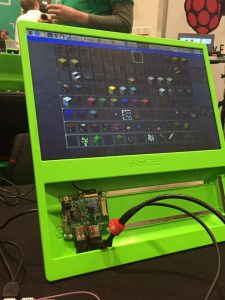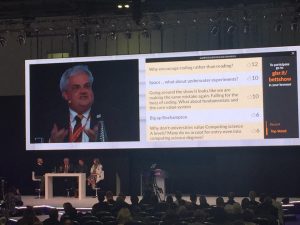Feb
2017
Lecture 6: The One With The Bett
On the 25th January I attended the Bett Show at the ExCel Centre, it is an international convention for all types of different technology worldwide. There were a lot of the big names in school based IT development present, for example Acer, Capita, Google and Raspberry Pi. However, there were also a lot of other exhibiters from across the world, some were specific programmes for example Monster Phonics and Lego Education.
 A particular stand of interest I went to look at was a Norwegian based coding company. They worked with sensors and Lego to create a robot which would be programmed to work in certain ways. The sensor built into the robot was programmed through an app which had block commands, when they were joined to the ‘starting’ block the robot would move. There was a wide range of sensors which could perform different commands, for example there were some that could flip or rotate the structure and others simply moved forwards and backwards. I think this would be a really good resource to be used within the classroom, and I would definitely use it, since the children are able to create their own creatures or robots. The children will be more engaged with the activity, since it is their creation which they will be programming. This can also be used for cross curricular activities: the children are able to design and make their creatures during DT lessons and then involve them in a story during their English lessons. This can link back to their IT, since they are able to act out the story on a floor mat that they’ve designed. After speaking to one of the exhibitors they directed me to Lego Education, which is their English partner, and where I would be able to purchase the kits and gain a greater understanding of what they offer.
A particular stand of interest I went to look at was a Norwegian based coding company. They worked with sensors and Lego to create a robot which would be programmed to work in certain ways. The sensor built into the robot was programmed through an app which had block commands, when they were joined to the ‘starting’ block the robot would move. There was a wide range of sensors which could perform different commands, for example there were some that could flip or rotate the structure and others simply moved forwards and backwards. I think this would be a really good resource to be used within the classroom, and I would definitely use it, since the children are able to create their own creatures or robots. The children will be more engaged with the activity, since it is their creation which they will be programming. This can also be used for cross curricular activities: the children are able to design and make their creatures during DT lessons and then involve them in a story during their English lessons. This can link back to their IT, since they are able to act out the story on a floor mat that they’ve designed. After speaking to one of the exhibitors they directed me to Lego Education, which is their English partner, and where I would be able to purchase the kits and gain a greater understanding of what they offer.
After a quick lunch break, I watched Miles Berry’s talk on Raspberry Pi, and how they are able to be used within the classroom. I found this talk interesting as it gave me an idea to the range of things that Raspberry Pi can be used for and how children are able to interact with it. They also publicised a magazine which was aimed at helping teachers plan lessons based on coding and how they are able to incorporate these into the classroom.
When I started to look at the exhibits again I found a piece of technology that was completely mind blowing. This was made by Nurva. They produced a projector which can be mounted to the wall, and emits infrared rays, and when they are broken act exactly like an interactive whiteboard- without the whiteboard! This means that the whole wall at the front of the classroom can be turned into an interactive screen. The projector has a 40ft width, which can scrolled through, therefore the whole days lessons can be planned onto one screen and simply pulled into view when they are needed. The teacher is able to make new notes and draw onto the wall using their finger and the options on the board, in this context it works exactly like an interactive whiteboard. Although, what makes it different, is that the children are able to link to the board using an app on the Ipads. They are able to make their own notes using these with their own personal copy of the board in the background. However, if the teacher has enabled it, they are able to swipe the notes onto the main board at the front of the classroom. This would be incredibly useful for research tasks or elicitation, for example the teacher can give the children a topic and they can write as many notes they want and swipe them onto the front to see each others ideas or answers. The children are not allowed to change anyone else’s comments either or anything on the original board. I absolutely love this, as the children are able to fully interact with the board, using their own devices. It not only enables the children to feel included and that every child can have their own say or comment put on the board, but it also saves time, meaning that the teacher doesn’t need to write everything that the children have said during the elicitation onto the board.
I also visited the Raspberry Pi area of the show, and gained some information on their ‘Code Clubs’. These are extra curricular coding clubs which can be set up by teachers and volunteers in the school, and supported by the Code Club network. I would defiantly look into setting up one, or helping with one within my school. Since it allows the children to develop a skill and hobby that can help them greatly when they are going to go into, not only, Secondary School but also when they go into looking for a job later in life. The clubs also bring like minded children together and helps them become known within a wider network of people, helping them to make friends and feel like they are part of something huge.
can be set up by teachers and volunteers in the school, and supported by the Code Club network. I would defiantly look into setting up one, or helping with one within my school. Since it allows the children to develop a skill and hobby that can help them greatly when they are going to go into, not only, Secondary School but also when they go into looking for a job later in life. The clubs also bring like minded children together and helps them become known within a wider network of people, helping them to make friends and feel like they are part of something huge.
It was defiantly beneficial to attend the show, since I was able to see a wide variety of what was available to schools and how they can impact the way teachers work and how it can make some simple tasks easier. I would like to go again next year and go to more of the talks, and see what else there is to offer within the area.
